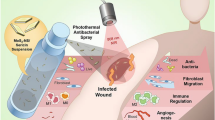Abstract
A bioadhesive wound-dressing material based on the combination of gelatin and chitosan with a proper ratio was developed and successfully applied in biomedical fields. The composite films were prepared with increase in chitosan concentration in a fixed amount of gelatin and were evaluated for mechanical stability (e.g., tensile strength, elongation-at-break), water and buffer uptake capacity, water and buffer aging, molecular structure, morphology, thermal stability, and for biological properties (e.g., antimicrobial activity, cytotoxicity, in vivo wound-healing performance). It is noteworthy that the 10:3 (gelatin:chitosan) composite films showed the best physico-mechanical, thermal, and antimicrobial properties among the other ratios blend films. The improved mechanical and thermal stability of the 10:3 composite film suggested its promising use as carrier for controlled release drug. The composite film was evaluated using a rat model for in vivo tests to ascertain the applicability of the proper ratio of the chitosan and gelatin in the film for best wound-healing activity. Wound sites dresses with gelatin/chitosan composite films showed excellent rapid healing of the wound surface than those dressed with eco-plaster and gauze. Within a day after dressing with 10:3 composite film, the healing efficiency was found to be 80 %.









Similar content being viewed by others
References
Cardona LR, Sanzgiri YD, Benedetti LM, Stella VJ, Topp EM (1996) Application of benzyl hyaluronate membranes as potential wound dressings: evaluation of water vapour and gas permeabilities. Biomaterials 17:1639–1643
Grzybowski J, Kolodziej W, Trafny E, Struzyna J (1997) A new anti-infective collagen dressing containing antibiotics. J Biomed Mater Res 36:163–166
Suzuki Y, Nishimura Y, Tanihara M, Suzuki K, Nakamura T, Shimizu Y, Yamawaki Y, Kakimura Y (1998) Evaluation of a novel alginate gel dressing: cytotoxicity to fibroblasts in vitro and foreign-body reaction in pig skin in vivo. J Biomed Mater Res 39:317–322
Yusof NLBM, Wee A, Lim LY, Khor E (2003) Flexible chitin films as potential wound-dressing materials: wound model studies. J Biomed Mat Res 66:224–232
Matsuda K, Suzuki S, Isshiki N, Ikada Y (1993) Re-freeze dried bilayer artificial skin. Biomaterials 14:1030–1035
Hinrichs IJ, Lommen EJ, Wildevuur CRH, Feijen J (1992) Fabrication and characterization of an asymmetric polyurethane membrane for use as a wound dressing. J Appl Biomater 3:287–303
Lahiji A, Sohrabi A, Hungerford DS, Frondoza CG (2000) Chitosan supports the expression of extracellular matrix proteins in human osteoblasts and chondrocytes. J Biomed Mater Res 51:586–595
Qu X, Wirsen A, Albertsson AC (2000) Novel pH sensitive chitosan hydrogel swelling behavior and states of water. Polymer 41:4589–4598
Mao JS, Zhao LG, Yin YJ, Yao KD (2003) Structure and properties of bilayer chitosan–gelatin scaffolds. Biomaterials 24:1067–1074
Mao JS, Cui YL, Wang XH, Sun Y, Yin YJ, Zhao HM, Yao KD (2004) A preliminary study on chitosan and gelatin polyelectrolyte complex cytocompatibility by cell cycles and apoptosis analysis. Biomaterials 25:3973–3981
Mi F-L (2005) Synthesis and characterization of a novel chitosan–gelatin bioconjugate with fluorescence emission. Biomacromolecules 6:975–987
Zhang Y, Ouyang H, Lim CT, Ramakrishna S, Huang Z-M (2005) Electrospinning of gelatin fibers and gelatin/PCL composite fibrous scaffolds. J Biomed Mater Res: Appl Biomater 72:156–165
Mao J, Zhao L, Yao KD, Shang Q, Yang G, Cao Y (2003) Study of novel chitosan–gelatin artificial skin in vitro. J Biomed Mater Res 64:301–308
Barnable P, Penicheand C, Monal WA (2005) Swelling behavior of chitosan/pectin polyelectrolyte complex membranes. Effect of thermal cross-linking. Polym Bull 55:367–375
Montero P, G`omez-Guill`en MC, Borderias AJ (1999) Functional characterization of muscle and skin collagenous material from hake (Merluccius merluccius L.). Food Chem 65:55–59
Johnston-Banks FA (1990) Gelatin. In: Harris P (ed) Food gels. Elsevier Applied Science Pub, London, pp 233–289
Acknowledgments
The authors thank the staff of Radiation and Polymer Chemistry Laboratory, Institute of Nuclear Science and Technology, Bangladesh Atomic Energy Commission for technical support and advice throughout the work.
Author information
Authors and Affiliations
Corresponding author
Rights and permissions
About this article
Cite this article
Parvez, S., Rahman, M.M., Khan, M.A. et al. Preparation and characterization of artificial skin using chitosan and gelatin composites for potential biomedical application. Polym. Bull. 69, 715–731 (2012). https://doi.org/10.1007/s00289-012-0761-7
Received:
Revised:
Accepted:
Published:
Issue Date:
DOI: https://doi.org/10.1007/s00289-012-0761-7




